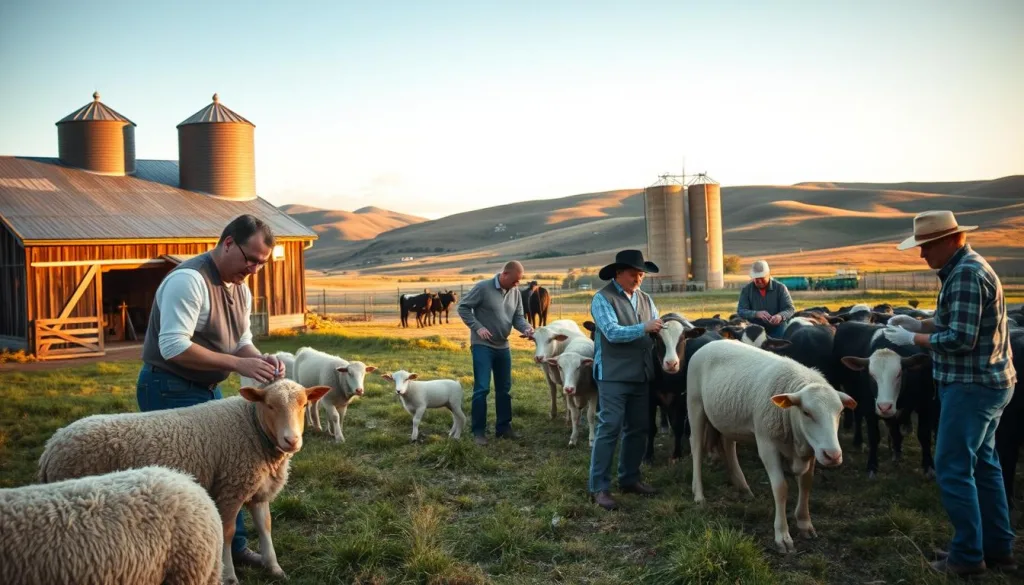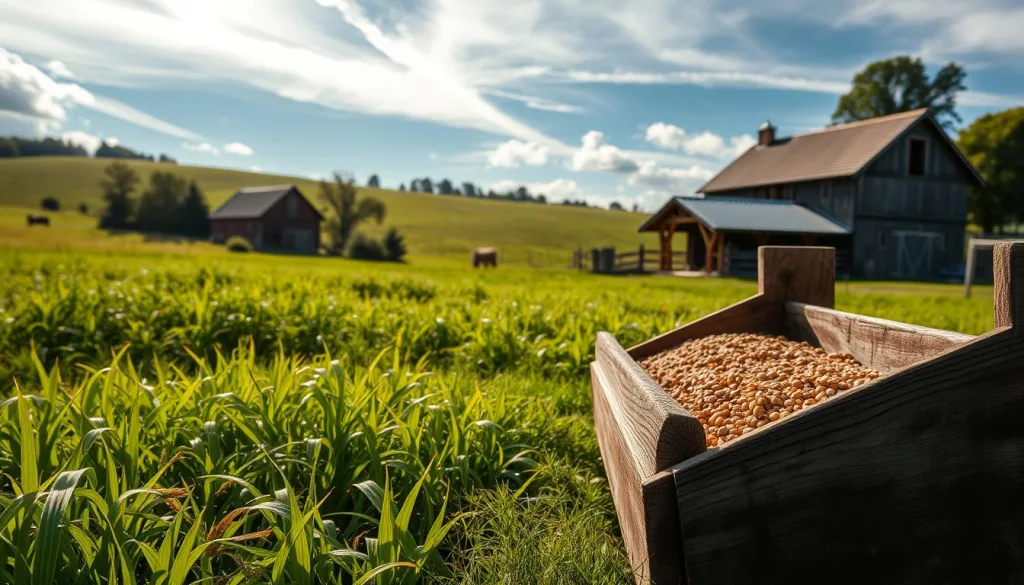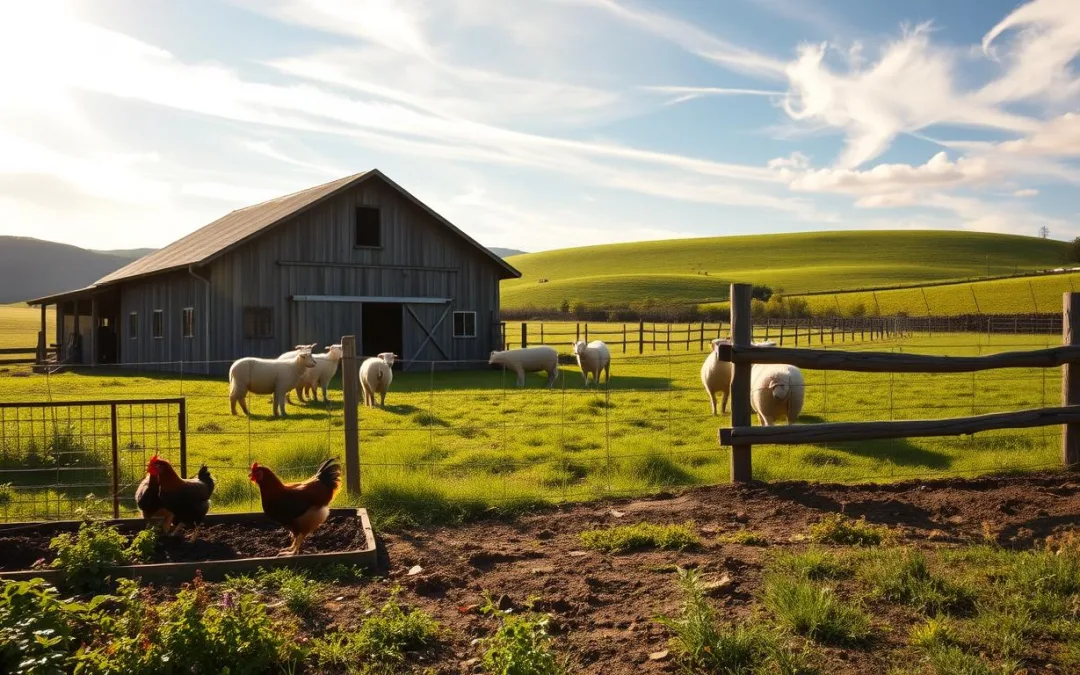Adding livestock to your homestead is a big step towards self-sufficiency. It needs careful planning, the right choices, and knowing what animals need. Also, you must understand what your land can handle.
Keeping animals like chickens, goats, ducks, and cattle can make your homestead more productive and green. Small farmers have many ways to make their farms better. Each animal adds something special to the land.
To manage livestock well, know your land’s limits, pick the right animal breeds, and build the right infrastructure. Miniature breeds need less space and food, which is great for smaller farms.
Key Takeaways
- Research local zoning regulations before acquiring livestock
- Select animal breeds compatible with your property’s size and resources
- Develop a complete plan for animal care
- Know the food and space needs of different animals
- Create lasting systems for feed, shelter, and waste
Understanding Homestead Livestock Basics
Raising animals on your property needs careful planning. Each animal has its own space, shelter, and care needs. Knowing which animals fit your land and resources is key to homestead management.
Choosing the right livestock is important for your homestead’s success. We’ll look at the best animals and what they need.
Types of Livestock for Small Homesteads
- Chickens: Easy to care for and great for beginners
- Need 2-3 square feet per bird inside the coop
- Give eggs and control pests
- Goats: Good for milk and meat
- Need about 15 square feet of indoor space
- Help clear brush and vegetation
- Sheep: Good for wool and meat
- Do well in different pastures
- Like to be in small groups
Space and Infrastructure Considerations
Different animals need different amounts of space. Here’s a quick guide to help you plan:
| Animal | Indoor Space | Outdoor Area |
|---|---|---|
| Chickens | 2-3 sq ft per bird | 4-5 sq ft per bird |
| Goats | 15 sq ft | 20-30 sq ft per goat |
| Donkeys | 48.4 sq ft | 1-2 acres |
When raising animals, good infrastructure is key. You’ll need strong shelters, fences, feeding stations, and water. Social animals like goats and sheep should be kept in pairs to avoid stress and promote health.
Remember: Successful sustainable livestock on homestead management starts with understanding each animal’s unique needs and providing the right care.
Assessing Your Property’s Capacity
When thinking about small scale animal husbandry, you need to look at several things. Backyard livestock management starts with knowing your land’s strengths and weaknesses.
Important things to check include:
- Local zoning regulations
- Total available land area
- Climate conditions
- Soil quality and composition
- Existing ecosystem and vegetation
The USDA’s research shows that mixing farming and animals can make land more productive. In fact, 85% of farmers said their soil got better when they added animals to their crops.
| Property Assessment Criteria | Impact on Livestock Management |
|---|---|
| Land Size | Determines number and type of animals |
| Soil Quality | Influences grazing capacity and nutrient availability |
| Climate | Affects animal health and shelter requirements |
| Zoning Restrictions | Defines permitted livestock types |
Doing a thorough property assessment is key to good backyard livestock management. Knowing your land’s special features helps you make a great place for your animals. It also helps you keep your practices sustainable.
Planning Your Livestock Integration Strategy
Adding animals to your homestead needs careful planning. A good strategy looks at many factors to make sure everything goes smoothly.
When planning to add livestock, think about a few important things. The cost can be $500 to $2,000 per animal. So, planning well is key to not spending too much.
Creating a Timeline for Animal Introduction
Introducing animals step by step helps everyone stay calm. Here are some key steps:
- Start with 2-3 animals of the same kind
- Learn what each animal needs
- Make a plan for introducing them slowly
- Save money for any surprises
Establishing Containment Systems
Keeping animals safe is very important. Protecting your investment means having the right fencing and shelters for each animal.
| Animal Type | Recommended Pasture Space | Fencing Requirements |
|---|---|---|
| Cattle | 1.5-2 acres per cow | Sturdy wire or electric fencing |
| Chickens | 100 sq feet per bird | Predator-proof mesh enclosures |
| Goats | 0.5 acres per goat | High, reinforced fencing |
Setting Up Feeding Stations
Smart feeding stations can save money and keep animals healthy. Farms that manage feeding well can cut costs by 10-15%.
Integrating livestock is more than adding animals. It’s about making a balanced, productive homestead.
Essential Health and Safety Protocols

Keeping your animals healthy is key to a successful homestead. It’s important to care for them in many ways. This includes preventing diseases and keeping them safe.
Starting with biosecurity is a smart move. It helps stop diseases from spreading. By managing your animals well, you can lower the risk of diseases.
Key Biosecurity Strategies
- Conduct regular veterinary health screenings
- Implement strict quarantine procedures for new animals
- Maintain clean and sanitized living environments
- Control visitor and equipment movement
- Establish dedicated disinfection zones
When you have many animals, you need to watch out for health issues. Using footbaths and cleaning vehicles can help stop diseases from spreading.
Health Monitoring Essentials
- Daily visual health inspections
- Track vaccination schedules
- Maintain detailed animal health records
- Recognize early signs of illness
Water treatment is also important for animal health. Using hydroxyl-based water can kill germs and help animals stay hydrated and digest better.
Proactive health management is always more cost-effective than reactive treatment.
Integrating Livestock into Your Homestead
Raising animals on your property needs careful planning. It’s important to have patience, knowledge, and a method to ensure animals are well. This helps in making the transition smooth.
When you bring new animals to your farm, several steps are key. They help reduce stress and prevent conflicts.
Quarantine Procedures
Quarantine is vital to protect your animals. A two-week isolation period stops disease spread. It also lets new animals adjust safely.
- Separate new animals in a dedicated quarantine area
- Observe animals for signs of illness
- Conduct initial health screenings
- Limit contact with existing herds
Introduction Methods
Slow introduction methods reduce stress. Create areas where animals can get used to each other slowly.
| Animal Type | Recommended Introduction Strategy | Duration |
|---|---|---|
| Goats | Visual contact through fence | 3-5 days |
| Chickens | Separate but adjacent enclosures | 1-2 weeks |
| Donkeys | Supervised shared pasture time | 7-10 days |
Monitoring and Adjustment Periods
Watching closely during the start is key. Look for changes in behavior, make sure they eat well, and be ready to adjust.
- Check animals multiple times daily
- Maintain consistent feeding schedules
- Provide ample water and shelter
- Document any health or behavioral concerns
Remember, successful livestock integration is about patience and attentive management.
Creating Sustainable Feed Systems

Creating sustainable feed systems is key for successful small scale animal husbandry. Homesteaders can make their livestock management better by using smart feeding strategies. These strategies help cut costs and boost animal nutrition.
Permaculture fodder systems bring new ways to feed animals well. They mix different feed sources to make strong nutrition networks. This helps animals stay healthy and cuts down on the need for outside feed. Regenerative agriculture practices show that good feed management can really boost farm productivity.
- Use fodder trees like willows and mulberries for 20-30% of animal food needs
- Put in leguminous shrubs to fix nitrogen and make forage better
- Make living fences that make land up to 50% more productive
Perennial fodder crops like alfalfa and chicory grow 2-3 times more than annual crops. They need less care and give steady nutrition for your animals.
| Feed Strategy | Productivity Increase | Cost Savings |
|---|---|---|
| Silvopasture Systems | 30-50% | 25-50% within 3-5 years |
| Leguminous Fodder | 15-25% Forage Quality | Reduced Fertilizer Needs |
| Adaptive Grazing | 30% Pasture Health | Enhanced Nutrient Cycling |
By using these sustainable methods, homesteaders can build strong feed systems. These systems support animal health, lower outside inputs, and help keep the farm ecosystem balanced.
Managing Multiple Species Together
Managing a backyard with different animals needs a smart plan. It’s about creating a peaceful place for all. By using livestock integration tips, you can make your land more productive and keep animals healthy.
Compatible Animal Combinations
Not every animal gets along. But, some pairs work well together. It’s all about knowing their habits and needs. Here are some good matches:
- Chickens with larger grazing animals like cattle or sheep
- Goats and sheep in shared pastures
- Ducks alongside cattle for pest control
Rotational Grazing Strategies
Rotational grazing keeps pastures healthy and stops overgrazing. Strategic movement of livestock makes grasslands grow back and soil better. Studies show it boosts soil health and life.
Preventing Inter-Species Conflicts
To keep peace among animals, you need to know their conflicts. Use separate feeding spots, enough room, and slow introductions. Watch how they act and build the right spaces for a calm place for all.
Integrated farming systems have shown they can handle big changes well.
Building Proper Housing and Shelter
Creating the right housing is key when you add animals to your homestead. Each type of animal needs its own shelter to stay healthy and happy. This is important for their well-being and how well they do their job.
Good shelter design is more than just keeping animals dry. It’s about knowing what each animal needs and making spaces that fit their natural ways. These spaces should also keep them safe from predators and harsh weather.
- Chickens need minimum 10 square feet per bird in outdoor spaces
- Provide one nesting box for every 4-5 hens
- Install fencing at least 6 feet tall with buried wire
- Ensure proper ventilation to manage moisture and odors
When designing shelters for your animals, think about these important points:
- How well it will work in different weather
- Keeping predators out
- Enough room for them to move around
- Being easy to clean and take care of
Using smart housing solutions can really help your animals. Strong, well-made shelters protect your animals and help your homestead run smoothly. They make a better place for your livestock to live and work.
Conclusion
Adding livestock to your homestead is a big step. It needs careful planning, dedication, and a willingness to learn. This guide has given you a strong start for a sustainable farm on your land.
It’s important to be patient and flexible when integrating livestock. Each animal has its own needs and benefits. For example, chickens give you eggs, while goats offer milk and friendship. Knowing how much space they need, what they eat, and how to keep them healthy is key.
Your journey with livestock is a continuous learning experience. Start with a few animals and grow your knowledge. Use local resources, go to workshops, and try new things. With passion and hard work, you’ll build a balanced farm that meets your needs and supports your green living goals.
Success in raising livestock depends on understanding their needs, having the right setup, and caring for them well. Face the challenges, celebrate the wins, and enjoy the journey of building a thriving homestead.
FAQ
What animals are best for a small homestead?
How much land do I need to raise livestock?
What are the most important considerations before adding livestock?
How do I prevent diseases in my livestock?
Can different livestock species be raised together?
What are the initial costs of starting with livestock?
How can I make livestock raising more sustainable?
Source Links
- Animals and Your Land: Homesteads Need the Presence of Livestock – EcoFarming Daily – https://www.ecofarmingdaily.com/animals-and-your-land-homesteads-need-the-presence-of-livestock/
- The Independent Farmstead: Start Your Homesteading Dream NOW | The Survival Gardener – https://thesurvivalgardener.com/the-independent-farmstead/
- Raising Livestock on Small Acreage Homestead: Maximizing Space and Resources – https://discover.texasrealfood.com/homesteading/raising-livestock-on-small-acreage-homestead
- How To Integrate New Animals On Your Farm Or Homestead – https://www.azurefarmlife.com/farm-blog/how-to-integrate-new-animals-on-your-farm-or-homestead
- Supporting Animals and Sustaining the Land in the Backyard and on the Homestead – https://extension.unh.edu/blog/2021/08/supporting-animals-sustaining-land-backyard-homestead-audio
- Homestead Dairy Cows: The Basics – https://watauga.ces.ncsu.edu/2020/04/homestead-dairy-cows-the-basics/
- PDF – https://www.usda.gov/sites/default/files/documents/usda-capacity-assessment.pdf
- Animal production and soil characteristics from integrated crop-livestock systems: toward sustainable intensification – https://pmc.ncbi.nlm.nih.gov/articles/PMC6095278/
- Crop–livestock integration beyond the farm level: a review – Agronomy for Sustainable Development – https://link.springer.com/article/10.1007/s13593-016-0390-x
- 5 Steps to Successfully Integrate Livestock into Your Farm Management Plan – https://www.bivatec.com/blog/5-steps-to-successfully-integrate-livestock-into-your-farm-management-plan
- Livestock and Crop Integration – Center for Regenerative Agriculture and Resilient Systems – https://www.csuchico.edu/regenerativeagriculture/ra101-section/integrating-livestock.shtml
- 10 Tips For Adding Livestock to your Crop Rotation – Rodale Institute – https://rodaleinstitute.org/blog/10-tips-for-adding-livestock-to-your-crop-rotation/
- Livestock Biosecurity 101: The Ultimate Guide to Thriving Animal Health – https://clearcomfort.com/livestock-biosecurity-101-guide/
- Prepare Livestock and Animals Ahead of Severe Weather – https://www.usda.gov/about-usda/news/blog/prepare-livestock-and-animals-ahead-severe-weather
- Improving Soil, Solving Problems, Increasing Income – ATTRA – Sustainable Agriculture – https://attra.ncat.org/publication/integrating-livestock-and-crops-improving-soil-solving-problems-increasing-income/
- How To Integrate Goats Into The Homestead • Insteading – https://insteading.com/blog/integrating-goats/
- Regenerative Agriculture Practices (On a Small Scale) – https://melissaknorris.com/podcast/regenerative-agriculture-practices-on-a-small-scale/
- Permaculture Fodder Systems: Growing Animal Feed – https://permaculturepractice.com/permaculture-fodder-systems/
- Animal Integration – https://regeneration.org/nexus/animal-integration
- Frontiers | Integrating Animal Husbandry With Crops and Trees – https://www.frontiersin.org/journals/sustainable-food-systems/articles/10.3389/fsufs.2020.00113/full
- Essential Guide to Animal Housing on Your Homestead – https://discover.texasrealfood.com/homesteading/homestead-animal-housing-essentials-VwRia
- 5 Critical Homestead Layout Guidelines: Smart Planning – https://theownerbuildernetwork.co/homestead-layout/
- Building a Sustainable Farm in Your Backyard: A Comprehensive Guide – Cutting Edge Landscape Design – https://www.thecuttingedgelandscape.com/building-a-sustainable-farm-in-your-backyard-a-comprehensive-guide/
- Comprehensive Guide to Animal Husbandry for Homesteaders: Best Practices and Tips – https://discover.texasrealfood.com/homesteading/animal-husbandry-for-homesteaders
- Back to Basics: Getting Started with Small Livestock – The Small Town Homestead – https://redemptionpermaculture.com/back-to-basics-getting-started-with-small-livestock/


